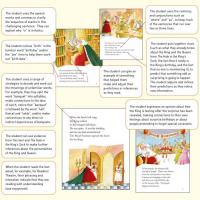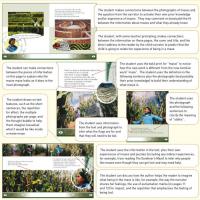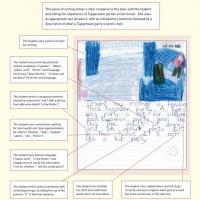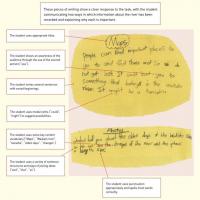After two years at school
The reading standard
The writing standard
The reading standard
After two years at school, students will read, respond to, and think critically about fiction and non-fiction texts at the Turquoise level of Ready to Read (the core instructional series that supports reading in the New Zealand Curriculum).
Key characteristics of texts at Turquoise level
Texts at Turquoise level have been designed with characteristics that include:
- some settings and contexts that may be outside the students’ prior knowledge but can easily be related to it
- a mix of explicit and implicit content that provides opportunities for students to make simple inferences
- illustrations that support the meaning and may suggest new ideas or viewpoints
- mostly familiar words, but some new topic words and descriptive language that are supported by the context (for example, the text may include synonyms, definitions, or explanations) and/or by illustrations
- some visual language features such as labelled diagrams, inset photographs, and bold text for topic words that are linked to a glossary
- a variety of sentence structures, including compound sentences and a few complex sentences, so that students are required to notice and use punctuation as a guide to phrasing and meaning
- frequent use of dialogue and more than one character speaking on a page.
These characteristics support the development of reading behaviours that are described on pages 10-11 and illustrated on the fold-out pages here.
Illustrating the reading standard
The King’s Birthday by Dot Meharry; illustrated by Philip Webb
This text is levelled at Turquoise 1.
In this humorous narrative, the King is upset because nobody seems to have remembered his birthday. The illustrations are rich with clues about what is really happening, but the King remains oblivious until he sits down to his royal lunch.This story has a traditional fairytale structure, starting with a problem, continuing with a series of events similar to each other (as the King tries to find out if anyone has remembered his special day), and finishing with a happy ending.
This is a sequel, with lots of humorous links, to The Hole in the King’s Sock (levelled at Orange), which is also available as a big book. This means that students are likely to be very familiar with the characters, setting, and fairytale-like text structure before they read this Turquoise text.
Some key challenges are the 'royal' vocabulary and the use of compound and complex sentences running over two or three lines.
This example highlights the sorts of reading behaviours teachers could expect to observe in students who are meeting the standard. Sometimes these behaviours will be in response to teacher prompts and questions, and sometimes they will be spontaneous as the students notice and respond to the ideas in the text. These behaviours may be during the first or subsequent readings and discussion.
Inside the Maize Maze by Sharon Holt; photographs by Anthony Russell
This text is levelled at Turquoise 2.
This non-fiction text begins with an explanation about what mazes are, continues with a recount about a child’s experience of navigating a maze, and ends with a brief report about a maze within a school playground.
Photographs, captions, definitions, and explanations provide support for working out the meanings of unfamiliar vocabulary.
The big idea in this text is that people throughout history have enjoyed the challenges that mazes provide.
Students are likely to be familiar with the concept of mazes before reading this text, either through their direct experience of mazes or through reading the humorous Ready to Read text The Gardener’s Maze (levelled at Green).
This example highlights the sorts of reading behaviours teachers could expect to observe in students who are meeting the standard. Sometimes these behaviours will be in response to teacher prompts and questions, and sometimes they will be spontaneous as the students notice and respond to the ideas in the text. These behaviours may be during the first or subsequent readings and discussion.
Return to top
The writing standard
After two years at school, students will create texts in order to meet the writing demands of the New Zealand Curriculum at level 1. Students will use their writing to think about, record, and communicate experiences, ideas, and information to meet specific learning purposes across the curriculum.
Key characteristics of students' writing at this level
Students will understand their purpose for writing and will write using a process and drawing on the knowledge, skills, and attitudes that will help them achieve their purpose. The knowledge, skills, and attitudes expected at this level, including those needed for spelling and punctuation, are described in the Literacy Learning Progressions.
Students will independently write simple texts. These texts will include, when appropriate:
- experiences, information, and/or ideas that relate to a curriculum topic, supported by some (mostly relevant) detail and/or personal comment
- mainly simple and compound sentences that have some variation in their beginnings
- simple conjunctions correctly used
- mainly personal content vocabulary, as well as words and phrases that are drawn from the student’s oral vocabulary and from the book language that they know
- some attempts at variety and precision in the use of adjectives, nouns, and verbs.
Illustrating the writing standard
‘The Tupperware Party’
The task exemplifies the writing demands of the English curriculum at level 1.
The students have been writing independently about a personal experience. They have been learning how to use planning tools, such as oral recounting, brainstorming, listing and sequencing ideas, and using simple pictures.
This is the student’s first draft. Features of the writing that demonstrate the standard are described below.
This example illustrates the sorts of writing that teachers can expect of students who are meeting the standard. To meet the standard, students draw on the knowledge, skills, and attitudes for writing described in the Literacy Learning Progressions for students at this level.
‘Stories along the River’
The task exemplifies the writing demands of the English and social sciences curriculum learning areas at level 1.
The learning context is a social studies inquiry into how and why people record information about special places, in this case, the Waikato River. The students have been for a walk along the river to look for ways in which important features of the river have been recorded. The students are working in groups to discuss what they have found out, but they are writing their own statements to share with their syndicate.
These are the student’s first drafts. Features of the writing that demonstrate the standard are described below.
This example illustrates the sorts of writing that teachers can expect of students who are meeting the standard. To meet the standard, students draw on the knowledge, skills, and attitudes for writing described in the Literacy Learning Progressions for students at this level.
Published on: 19 Oct 2009
Return to top





